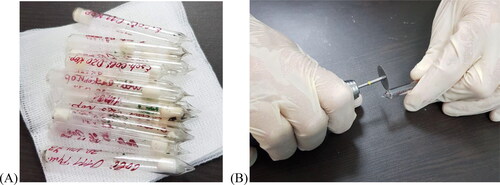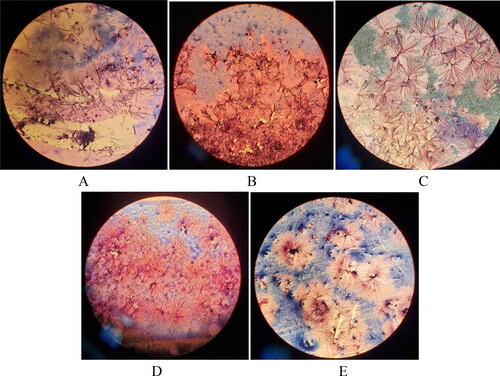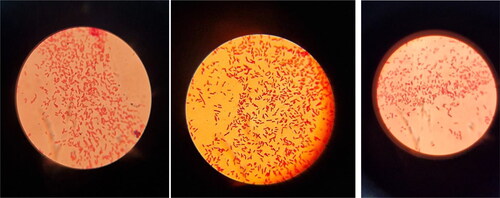Figures & data
Figure 1. Ampoules with 14 lypophilized strains of Escherichia coli (А), with production dates between 1971 and 1981. Opening of the ampoules (B) by using a dental micromotor with a diamond separator.

Figure 2. First seeding of fourteen Escherichia coli strains after 40–50 years of storage.
Note: Top row from left to right (number in the study 1–7) – O7, O111, O25, O20, O11, O125 and O111; bottom row from left to right (number in the study 8–14) – O29, O26, O5, O1, O125, O2 and O2.

Figure 3. Microscopic pictures of Escherichia coli (А-E). after initial cultures of the strains from the lyophilized form stored for four to five decades. Slides were prepared by Gram staining and were observed under immersion system, 100x (Carl Zeiss Microscopy GmbH, Primo star).
Note: E. coli strains O7 (A), O11 (B), O25 (C), O111 (D) and O125 (E).

Figure 4. Bacterial colonies of Escherichia coli on Eosin methylene blue.
Note: Top row from left to right (number in the study 1–7) – O7, O111, O25, O20, O11, O125 and O111; bottom row from left to right (number in the study 8–14) – O29, O26, O5, O1, O125, O2 and O2.

Figure 5. Microscopic images of Escherichia coli after re-cultivation (24 h at 37 °C) of the strains from the lyophilized form stored for four to five decades. Slides were prepared by Gram staining and were observed under immersion system, 100x (Carl Zeiss microscopy GmbH, Primo star).
Note: E. coli strains from left to right O11, O25 and O111.

Table 1. Results of test agglutination with Escherichia coli strains stored for four to five decades in lyophilized form.
Table 2. Biochemical profile of Escherichia coli serotypes on Kligler’s iron agar (KIA).
Table 3. Antimicrobial sensitivity of Escherichia coli strains tested by the disk-diffusion test.
Data availability statement
All data that support the findings reported in this study are available from the corresponding author upon reasonable request.
